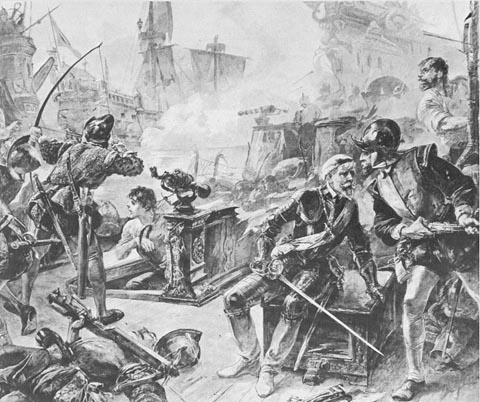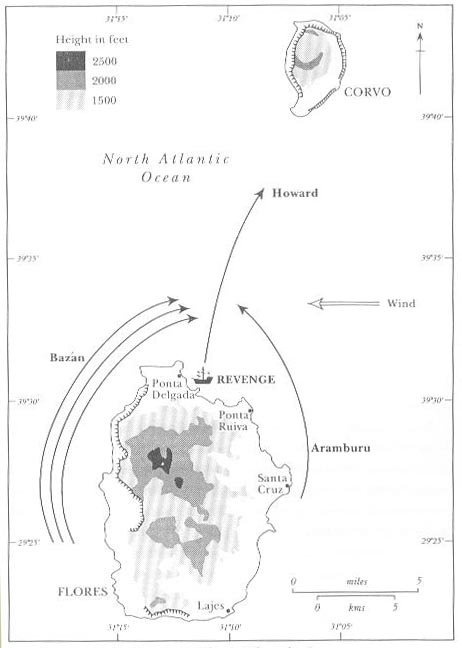Battle Of Flores (1591) on:
[Wikipedia]
[Google]
[Amazon]
The Battle of Flores was a naval engagement during the


 Bazán tried to surprise the English fleet at anchor, but Sancho Pardo's vice-flagship lost their
Bazán tried to surprise the English fleet at anchor, but Sancho Pardo's vice-flagship lost their
Brittany Campaign
The Brittany Campaign or the Campaign of Brittany was a military occupation of the Brittany region of France by Spain. It began in the summer 1590 when Philippe-Emmanuel de Lorraine, Duke of Mercœur and governor of Brittany, offered the ...
of the Anglo-Spanish War of 1585 fought off the Island of Flores between an English fleet of 22 ships under Lord Thomas Howard
Lord Thomas Howard (1511 – 31 October 1537) was an English courtier at the court of King Henry VIII. He is chiefly known for his marriage (later invalidated by Henry) to Lady Margaret Douglas (1515–1578), the daughter of Henry VIII's si ...
Fernández Duro p. 80 and a Spanish fleet of 55 ships under Alonso de Bazán
Alonso de Bazán, son of Admiral Álvaro de Bazán the Elder, Marquis del Viso, and brother of the better known Admiral Álvaro de Bazán, 1st Marquis of Santa Cruz, was a Spanish naval commander during the Anglo–Spanish War (1585–1604) and t ...
. Sent to the Azores
)
, motto =( en, "Rather die free than subjected in peace")
, anthem= ( en, "Anthem of the Azores")
, image_map=Locator_map_of_Azores_in_EU.svg
, map_alt=Location of the Azores within the European Union
, map_caption=Location of the Azores wi ...
to capture the annual Spanish treasure convoy, when a stronger Spanish fleet appeared off Flores, Howard ordered his ships to flee to the north,Paine p. 150 saving all of them except the galleon ''Revenge
Revenge is committing a harmful action against a person or group in response to a grievance, be it real or perceived. Francis Bacon described revenge as a kind of "wild justice" that "does... offend the law ndputteth the law out of office." Pr ...
'' commanded by Admiral Sir Richard Grenville
Sir Richard Grenville (15 June 1542 – 10 September 1591), also spelt Greynvile, Greeneville, and Greenfield, was an English privateer and explorer. Grenville was lord of the manors of Stowe, Cornwall and Bideford, Devon. He subsequently ...
.
After transferring his ill crewmen onshore back to his ship, he led the ''Revenge'' in a rearguard action against 55 Spanish ships, allowing the English fleet to retire to safety. The crew of the ''Revenge'' sank and damaged several Spanish ships during a day-and-night running battle. The ''Revenge'' was boarded many times by different Spanish ships, and repelled each attack successfully. When Admiral Sir Richard Grenville was badly wounded, his surviving crew surrendered. Alfred, Lord Tennyson
Alfred Tennyson, 1st Baron Tennyson (6 August 1809 – 6 October 1892) was an English poet. He was the Poet Laureate during much of Queen Victoria's reign. In 1829, Tennyson was awarded the Chancellor's Gold Medal at Cambridge for one of his ...
, wrote a poem about the battle, entitled ''The Revenge: a Ballad of the Fleet''.
Background
In order to impede a Spanish naval recovery after the Armada, SirJohn Hawkins
John is a common English name and surname:
* John (given name)
* John (surname)
John may also refer to:
New Testament
Works
* Gospel of John, a title often shortened to John
* First Epistle of John, often shortened to 1 John
* Second ...
proposed a blockade of the supply of treasure being acquired from the Spanish Empire
The Spanish Empire ( es, link=no, Imperio español), also known as the Hispanic Monarchy ( es, link=no, Monarquía Hispánica) or the Catholic Monarchy ( es, link=no, Monarquía Católica) was a colonial empire governed by Spain and its prede ...
in the Americas
The Americas, which are sometimes collectively called America, are a landmass comprising the totality of North and South America. The Americas make up most of the land in Earth's Western Hemisphere and comprise the New World.
Along with th ...
by a constant naval patrol designed to intercept Spanish ships. ''Revenge'' was on such a patrol in the summer of 1591 under the command of Sir Richard Grenville
Sir Richard Grenville (15 June 1542 – 10 September 1591), also spelt Greynvile, Greeneville, and Greenfield, was an English privateer and explorer. Grenville was lord of the manors of Stowe, Cornwall and Bideford, Devon. He subsequently ...
. The Spanish, meanwhile, had dispatched a fleet of some 55 ships under Alonso de Bazán, having under his orders Generals Martín de Bertendona and Marcos de Aramburu.Fernández Duro p. 79 Bazán learned that the English were patrolling around the northern Azores. In late August 1591, having been joined by 8 Portuguese flyboat The flyboat (also spelled fly-boat or fly boat) was a European light vessel of Dutch origin developed primarily as a mercantile cargo carrier, although many served as warships in an auxiliary role because of their agility. These vessels could displa ...
s under Luis Coutinho, the Spanish fleet came upon the English. Howard's fleet was caught while undergoing repairs and when the crews, many of whom were suffering an epidemic of fever, were resting ashore.
Battle


 Bazán tried to surprise the English fleet at anchor, but Sancho Pardo's vice-flagship lost their
Bazán tried to surprise the English fleet at anchor, but Sancho Pardo's vice-flagship lost their bowsprit
The bowsprit of a sailing vessel is a spar extending forward from the vessel's prow. The bowsprit is typically held down by a bobstay that counteracts the forces from the forestays. The word ''bowsprit'' is thought to originate from the Middle L ...
, forcing the attack to be delayed. It was not until 5 pm that Bazán's ships bore down the channel which separated Flores and Corvo islands. Howard, alerted to the arrival of the Spanish, managed to slip away to sea. An exchange of fire took place between both fleets before they became separated. Grenville, however, preferred to fight and went straight through the Spaniards, who were approaching from the eastward.
Meanwhile, ''Defiance'', Howard's flagship, received heavy gunfire from Aramburu's ''San Cristóbal'' before withdrawing from the battle. ''Revenge'' was left behind and directly engaged by Claudio de Viamonte's ''San Felipe''. Viamonte boarded the English galleon, suffering the misfortune of the grappling hook parting after having only passed 10 men aboard her. Shortly after Martín de Bertendona's ''San Bernabé'' did the same, this time successfully, and managed to rescue seven survivors of ''San Felipe''s boarding party. ''San Bernabé''s grappling was decisive to the fate of ''Revenge'', because the English warship lost the advantage of her long-range naval guns. Conversely, the heavy musket
A musket is a muzzle-loaded long gun that appeared as a smoothbore weapon in the early 16th century, at first as a heavier variant of the arquebus, capable of penetrating plate armour. By the mid-16th century, this type of musket gradually d ...
ry fire of the Spanish infantry forced the English gunners to abandon their post in order to repulse the attack.
At dusk, having dispersed the bulk of the English fleet, ''San Cristobal'' rammed ''Revenge'' underneath its aftcastle
An aftercastle (or sometimes aftcastle) is the stern structure behind the mizzenmast and above the transom on large sailing ships, such as carracks, caravels, galleon
Galleons were large, multi-decked sailing ships first used as arm ...
, putting on board of the English ship a second boarding party which captured her colours. The Spanish soldiers got as far forward as the mainmast before being forced to retreat, due to heavy musketry fire from the aftcastle. ''San Cristóbal''s bow had been shattered by the ramming, and she had to ask for reinforcements. Antonio Manrique's ''Asunción'' and Luis Coutinho's flyboat ''La Serena'' attacked at the same time, increasing the number of ships beating the ''Revenge'' to five, which was still grappled by the galleons ''San Bernabé'' and the damaged ''San Cristóbal''. Grenville held them back with cannon and musket fire until, being himself badly injured and ''Revenge'' severely damaged, completely dis-masted and with 150 men killed or unable to fight, surrendered. During the night Manrique's and Coutinho's ships sank after they collided with each other.
Aftermath
Despite the damage Grenville had inflicted, the Spanish treated ''Revenge''s survivors honourably.Simpson p. 101 Grenville, who had been taken aboard Bazán's flagship, died two days later. The Spanish Treasure Fleet rendezvoused with Bazán soon afterward, and the combined fleet sailed to Spain. They were overtaken by a week-long storm during which ''Revenge'' and 15 Spanish warships and merchant vessels were lost. ''Revenge'' sank with her mixed prize-crew of 70 Spaniards and English prisoners near the island ofTerceira
Terceira () is a volcanic island in the Azores archipelago, in the middle of the North Atlantic Ocean. It is one of the larger islands of the archipelago, with a population of 53,311 inhabitants in an area of approximately . It is the location ...
, at the approximate position .Earle p. 159
The battle, however, marked the resurgence of Spanish naval powerHammer p. 166 and proved that the English chances of catching and defeating a well-defended treasure fleet were remote. It also hinted at what might have happened in Gravelines
Gravelines (, ; ; ) is a commune in the Nord department in Northern France. It lies at the mouth of the river Aa southwest of Dunkirk. It was formed in the 12th century around the mouth of a canal built to connect Saint-Omer with the sea. As ...
in 1588 if Medina Sidonia
Medina Sidonia is a city and municipality in the province of Cádiz in the autonomous community of Andalusia, southern Spain. Considered by some to be the oldest city in Europe, it is used as a military defence location because of its elevation. ...
had succeeded in luring the English ships within grappling range of the Armada, and if the cannonballs had actually fitted the Spanish cannon (they had been manufactured in different areas of the Spanish Habsburg Empire, and so were not all designed in the same way, shape, or size).
See also
*Spanish treasure fleet
The Spanish treasure fleet, or West Indies Fleet ( es, Flota de Indias, also called silver fleet or plate fleet; from the es, label=Spanish, plata meaning "silver"), was a convoy system of sea routes organized by the Spanish Empire from 1566 to ...
* Islands Voyage
The Islands Voyage, also known as the Essex-Raleigh Expedition, was an ambitious, but unsuccessful naval campaign sent by Queen Elizabeth I of England, and supported by the United Provinces, against Spain during the Anglo–Spanish War (1585 ...
References
Bibliography
* * * * * * {{DEFAULTSORT:Flores, Battle of 1591 Naval battles of the Anglo-Spanish War (1585–1604) Conflicts in 1591 1591 in Europe Battles in the Azores 1591 in the British Empire 1591 in the Spanish Empire 1591 in Portugal